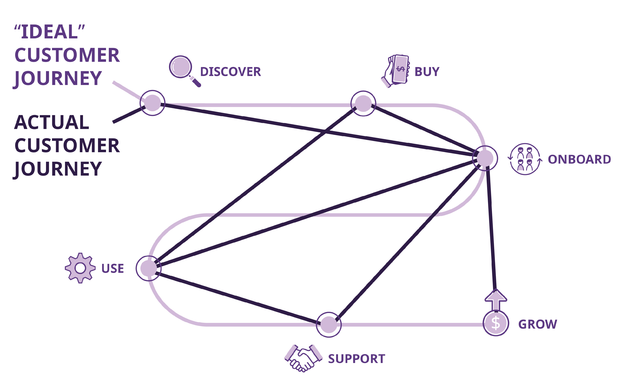Life is a journey. While this common saying is true, it’s oversimplified. Life is made up of many journeys, and each person has different destinations, itineraries and experiences along the way. Customer journeys are similarly varied and unique. Just as personal journeys shape individuals, customer journeys define the customer experience (CX).
Businesses must improve customer journeys to enhance CX and increase retention. Yet many business leaders don’t understand this popular buzzword. According to a Forrester survey of 484 global CX leaders, 40% indicated that lack of understanding or appreciation for customer journeys is a major challenge to delivering a successful CX.
But as the popular Chinese proverb goes, “A journey of a thousand miles begins with one step.” In the journey toward better CX, that important first step is to recognize and appreciate the underlying customer journey across interactions.
A customer journey is a series of interactions that a customer has with a brand for any particular task or decision. The customer decides what actions to take at each step in the process, but the business has an opportunity to guide those decisions and behaviors toward the desired outcome.
Customer journeys occur during all six stages of the customer experience lifecycle:
-
-
- Discover (research products and services)
- Buy (purchase goods or services, apply for a bank account)
- Onboard (receive products, activate accounts or services)
- Use (change communication preferences, receive fraud alerts)
- Support (pay bills, receive outage notifications, return a purchased item)
- Grow (receive targeted offers, renew contract)
-
The above view captures all the possible interactions a business can have with a customer; yet, many brands focus primarily on the purchase journey. Interactions after the sales transaction are equally—if not more—important for customer experience and retention.
A customer journey includes various touchpoints and channels because customers interact with brands via many channels: website, email, text messages, mobile app, social media, voice (call center) and brick-and-mortar stores. Someone on a bill pay journey may open an email or text message on their phone (“Your payment is due soon”), click on a link to review the bill, and then call customer service after spotting an error. A few days later, the customer uses their laptop to pay the bill online. Businesses must make it simple for customers to complete each step without them having to start over when they switch channels, devices or even moments in time.
Related Blog: Great CX Requires More Than a CDP
A Customer Journey Is NOT Linear or One-Size-Fits-All
While we always have an “ideal” journey in mind, in life and in business, it almost never unfolds that way. Customers don’t progress directly from point A to point B—they bounce around, backwards and between, the steps outlined in a journey map. Often, purchase journeys are not as straightforward as seeing an ad, going to the store and purchasing the product. Customers may take many, varied steps (that often loop back on each other) between awareness/discovery and purchase. Someone may view social media ads, place an item in the shopping cart, browse other companies’ websites, abandon the cart, complete the purchase a few days later, call to check on delivery status, and then return the item when it doesn’t fit.
Customers can be on multiple journeys at the same time. Almost half (44%) of global CX leaders surveyed, indicated that customers are engaging in multiple journeys and expect their company to be aware of and sensitive to all of them. For example, a recent grad may have just purchased another credit card with travel-related benefits. If they are still ramping up with their new card, it’s not the right time to ask them to get the latest ultra platinum credit card with a $30,000 spending limit.
How can you send the right messages at the right time, guiding customers through the next best action or experience?
Journey Orchestration Makes Any Customer Experience an Ideal One
A static linear journey will only go so far to satisfy customers and build loyalty. With a journey-centric approach, customers control their interactions and journeys with the brand from acquisition and onboarding to support and retention. Thus any journey must be orchestrated in real time to be successful.
Journey orchestration refers to using real-time customer data to analyze current behavior, predict future behavior and send the right messages at the right time via the customer’s preferred communication channel. Journey orchestration allows you to guide customers’ behavior, adjusting the experience in real time regardless of channel, time or place.
Related Report: State of Customer Experience 2023 Report
What do successfully orchestrated journeys look like?
Telco/Communication Service Providers: Promo roll off journey
As customers approach their contract renewal date, determine and send the best upgrade offer (based on each customer’s usage history) via their preferred communication channel. Customers who don’t engage with the targeted offer receive follow-up message. The save/retention team contacts customers who don’t respond to the upgrade offer.
Financial Services: Bill pay journey
Detects that a customer has been issued a bill and the due date is approaching. Sends one or more notifications via the preferred channel, reminding the customer to pay on time to avoid late fees. If the customer doesn’t pay on time, the system triggers a collections journey.
Retail: Abandoned cart journey
Identify if products have been abandoned in a shopping cart. The system determines and sends the right message (perhaps a discount offer) to nudge the customer to complete the purchase. Then notify the customer after the order has been placed, indicating when the product will be delivered or ready for pick-up.
Healthcare: Appointment management journey
Proactively remind the patient (via voice, email or text) that it’s time to schedule the annual checkup (via phone or patient portal). After the patient schedules the appointment, follow up accordingly with appointment reminders via the patient’s preferred communication channel (voice, email or text).
Take the First Step with CSG Xponent Ignite
CSG Xponent Ignite, our customer experience solution, includes pre-built customer journeys for four industries: telecommunications, financial services, retail and healthcare. The foundation of Xponent Ignite is CSG Xponent, our industry-leading, award winning platform that includes a feature-rich and fully embedded customer data management/platform layer (CDP), customer journey orchestration and journey analytics to analyze customer behavior, sentiment and preferences to deliver the right personalized messages at the right time.
It’s time to make every customer journey an ideal experience. Contact us today.


